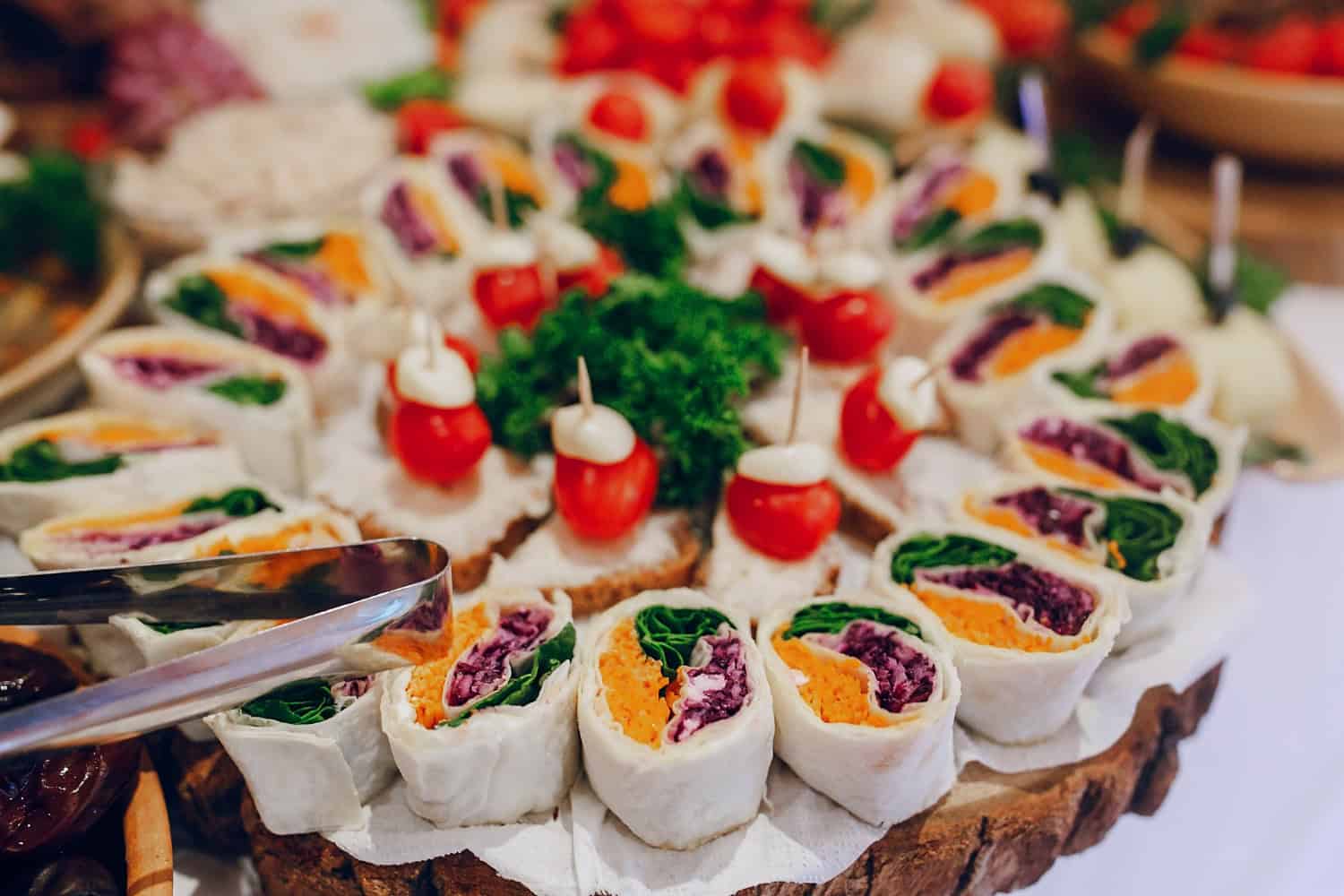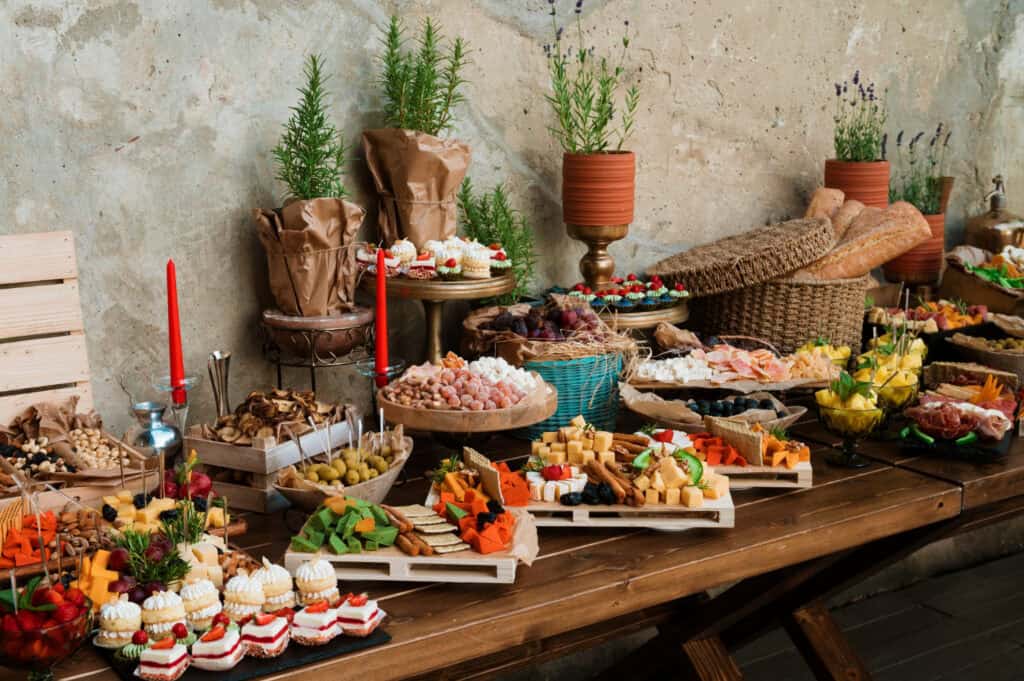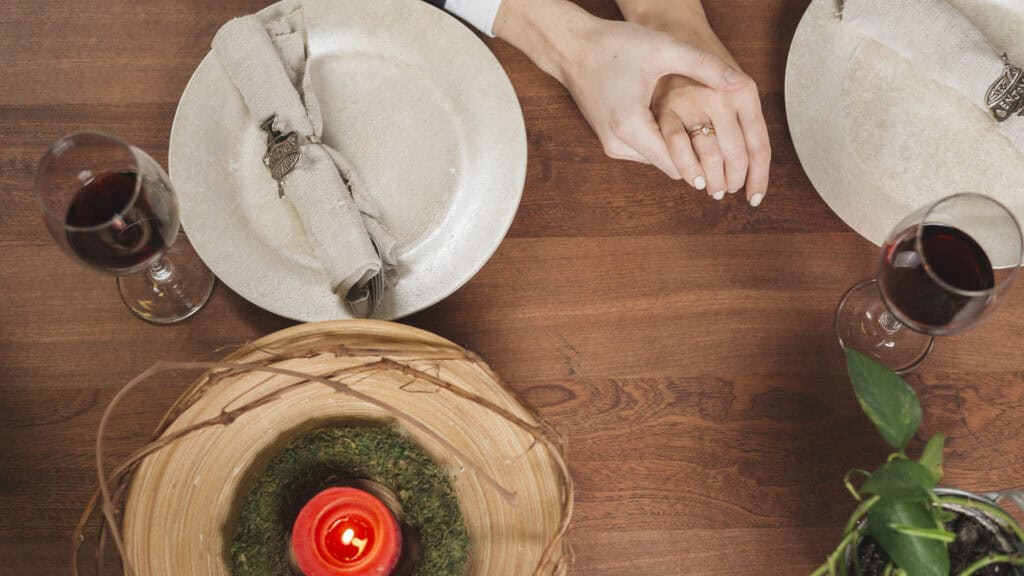
By Jermaine Thomas June 18, 2025
When guests sit down for a meal, they notice more than just the food. The setting, lighting, table linens, and even how the furniture is arranged can shape their entire dining experience. From fine dining events to casual catered gatherings, creating the right atmosphere is just as important as what’s served on the plate. This is why environmental elements such as lighting, linens, and layouts play a central role in how food is perceived and enjoyed.
Because they know how important presentation is, catering professionals and planners take their time when designing the dining area. A thoughtful dining arrangement can improve the food appeal, promote relaxation, and even affect how long guests stay. These subtle clues influence expectations, mood, and ultimately how much the meal is enjoyed overall.
The Impact of Lighting on Food Appeal
Lighting is one of the most influential environmental elements in any dining setting. It can affect not only how food looks but also how it tastes. Studies have shown that color and brightness levels in lighting can influence appetite, mood, and even the perception of flavor.
Warm, soft lighting often makes a space feel more intimate and inviting. This type of light brings out the natural tones in food, making it appear more vibrant and appealing. In contrast, harsh or overly bright lighting can create a sterile or clinical feel that detracts from the richness of the meal. Dim lighting, when used correctly, encourages longer conversations and relaxed dining, which is ideal for weddings and upscale banquets.
Adjustable lighting can be a game-changer in different event types. For afternoon luncheons, natural light may be used to enhance freshness. In evening events, strategic spotlighting can highlight signature dishes or dessert stations, drawing attention where it matters most. When planning a food presentation environment, lighting must be tailored to the menu, time of day, and desired tone of the event. Color temperatures also matter. A cooler tone may suit a minimalist modern setup, while golden tones suit rustic and homestyle meals.

Choosing the Right Linens for Visual Harmony
Linens are more than decorative elements. They serve as the backdrop for every plate and glass on the table. The right choice in linens helps define the theme of an event, adds texture and contrast, and complements the food being served.
Crisp white linens are a classic choice that allows the colors of the food to stand out. They create a clean and professional aesthetic and are suitable for nearly any event. For a more vibrant or seasonal theme, colored linens can reflect the mood. Earthy tones go well with fall menus, while pastels may suit spring brunches.
Texture is also important. A formal dinner can be made more elegant with satin or silk finishes, but a farmhouse-style gathering might look better with burlap or cotton. Chair sashes, table runners, and napkins should all be complementary without being overly similar, providing depth and variation. The way that guests use the dining area is also influenced by the linens. How guests view cleanliness and attention to detail is influenced by the quality of the fabric. Even the most exquisitely prepared food can lose its elegance quickly due to stains or wrinkles.
Thoughtful linen selection is one of the simplest catering setup ideas that enhances the dining ambience. When done well, linens contribute to a sense of care and refinement that complements the entire food service.
Layout Design and Its Influence on Flow
The arrangement of tables, food stations, and service paths plays a vital role in guest comfort and service efficiency. A poorly planned layout can result in traffic jams, awkward seating, and a disconnected guest experience. On the other hand, a carefully designed layout can make the event feel open, welcoming, and intuitive.
When creating a layout for any catered event, it’s important to start with the guest count and type of service. Buffet layouts, for example, should be organized to prevent bottlenecks, with enough space between stations for guests to move comfortably. Seated dinners require adequate spacing between tables for servers to move freely without disturbing guests.
Incorporating focal points like a carving station or dessert bar can help distribute foot traffic and guide guests naturally through the space. Round tables are often favored for promoting conversation and balance, while long banquet-style tables can feel communal and dramatic. Layout design should also align with the food appeal environment. Positioning stations near decorative elements, such as floral arrangements or candles, adds to the sensory experience. The goal is to make every corner of the room feel deliberate and harmonious.
A well-structured layout not only supports the practical flow of the event but also enhances how guests experience food. When guests are comfortable, relaxed, and can navigate easily, their focus remains on enjoying the meal.
Harmonizing the Dining Ambience Through Sensory Cues

Beyond the visual and spatial elements, dining ambience is influenced by a mix of subtle sensory cues. While lighting, linens, and layouts provide the foundation, the overall environment is also shaped by sound, scent, and even temperature. Soft background music can elevate mood without becoming distracting. It can also fill silence in larger rooms, helping to maintain a welcoming energy. Instrumental music or curated playlists that match the event theme can contribute to a cohesive experience.
Another element that is often overlooked is scent. A subtle scent from floral arrangements or freshly baked bread can improve the impression of comfort and freshness, but strong artificial scents should be avoided. Items with strong scents shouldn’t be placed too close to food because this could overpower the natural flavours. Another factor is temperature. A room that is too hot or too cold can make visitors less patient and less hungry. To maintain a comfortable dining area, event planners should make sure climate control systems are tested in advance.
These extra elements complete the food appeal environment and contribute to the feeling of immersion. Together, they create an atmosphere where guests not only taste food but enjoy it fully through every sense.
Color Psychology in Dining Spaces
Color choices in a dining area do more than decorate; they evoke emotion. From walls and ceilings to dishware and napkins, color influences appetite, mood, and even how guests rate the taste of food. Warm colors like red, orange, and yellow are known to stimulate appetite and increase energy. They are often used in fast-casual dining settings. On the other hand, soft blues and greens can encourage calmness and are ideal for spa-themed brunches or health-conscious catering events.
Neutral palettes like beige, grey, or taupe provide a blank canvas that allows food to become the star. These shades work well in upscale dining where elegance and refinement are key. Combining these neutrals with splashes of color from flowers, dishes, or table settings adds character without overwhelming the space.
Understanding how color works with other environmental elements helps planners shape a well-balanced dining ambience. Every design choice sends a signal, and thoughtful color application can subconsciously elevate the entire meal experience.
Furniture and Tableware that Elevate Presentation
While linens cover the tables, the underlying furniture also contributes to the aesthetic. Tables, chairs, and serving stations should align with the event’s theme and offer both comfort and functionality. Rustic wood tables may suit farm-to-table meals, while mirrored or lacquered surfaces add drama to gala dinners.
Tableware selection, including plates, glasses, and cutlery, plays an equally critical role. The shape, size, and color of plates can dramatically affect how food is viewed. White plates are a common choice because they let ingredients stand out. However, black, glass, or patterned dishes can also enhance presentation when paired thoughtfully.
A sense of ceremony is added by accents like elegant chargers, stemmed glasses and polished silverware. They transform simple meals into carefully planned dining experiences. Even condiment holders, butter dishes, and bread baskets add to the visual narrative. Catering crews can enhance their food appeal space and produce dishes that guests will remember long after the event by making investments in fine, theme-appropriate furniture and tableware.
Seasonal and Thematic Integration
Adapting your catering setup ideas to seasonal themes can dramatically enhance guest engagement and sensory pleasure. In spring, lighter linens, fresh flowers, and pastel colors make meals feel fresh and lively. Summer events can incorporate bold colors, open layouts, and plenty of natural light. Autumn themes benefit from warm tones, textured fabrics like burlap or tweed, and layouts that emphasize comfort. In winter, luxurious linens, candlelight, and darker color schemes create warmth and elegance. Incorporating seasonal ingredients in both decor and menu strengthens the overall narrative.
Theme-based setups such as tropical nights, wine tastings, or vintage-inspired evenings require careful coordination of every detail. From chair covers to glassware, consistency reinforces immersion and improves guest satisfaction. Catering is about more than feeding people. When you align the dining ambience with a theme or season, you enhance emotional connection and encourage guests to savor the full experience, not just the food.

Flexibility and Adaptability in Setup Design
No two events are alike, and flexibility is a critical trait of successful environmental design. Whether adapting to an indoor venue, outdoor garden, small business meeting, or large wedding, caterers must tailor their layout and setup to fit the space and expectations. Portable lighting, modular furniture, and linens in a variety of colors and materials allow for greater customization. Planning for multiple scenarios such as unexpected rain or last-minute guest additions demonstrates professionalism and readiness.
Even the most beautiful setting for food presentation needs to be practical. Priorities should always include safe routes for servers, clear sight lines, and accessibility for visitors with special needs. The most effective arrangements create smooth interactions between customers, food, and service personnel by combining elegance and usability. In addition to promoting logistical success, versatile design guarantees that the visual appeal stays despite any obstacles.
Conclusion
Creating a memorable dining experience goes beyond the menu; it’s about crafting an inviting atmosphere. Thoughtful elements like lighting, layout, and linens elevate how food is seen, tasted, and enjoyed. Smart catering setups enhance both service and ambiance, turning meals into lasting memories. Whether for a wedding or a small gathering, every detail shapes a joyful, immersive experience.